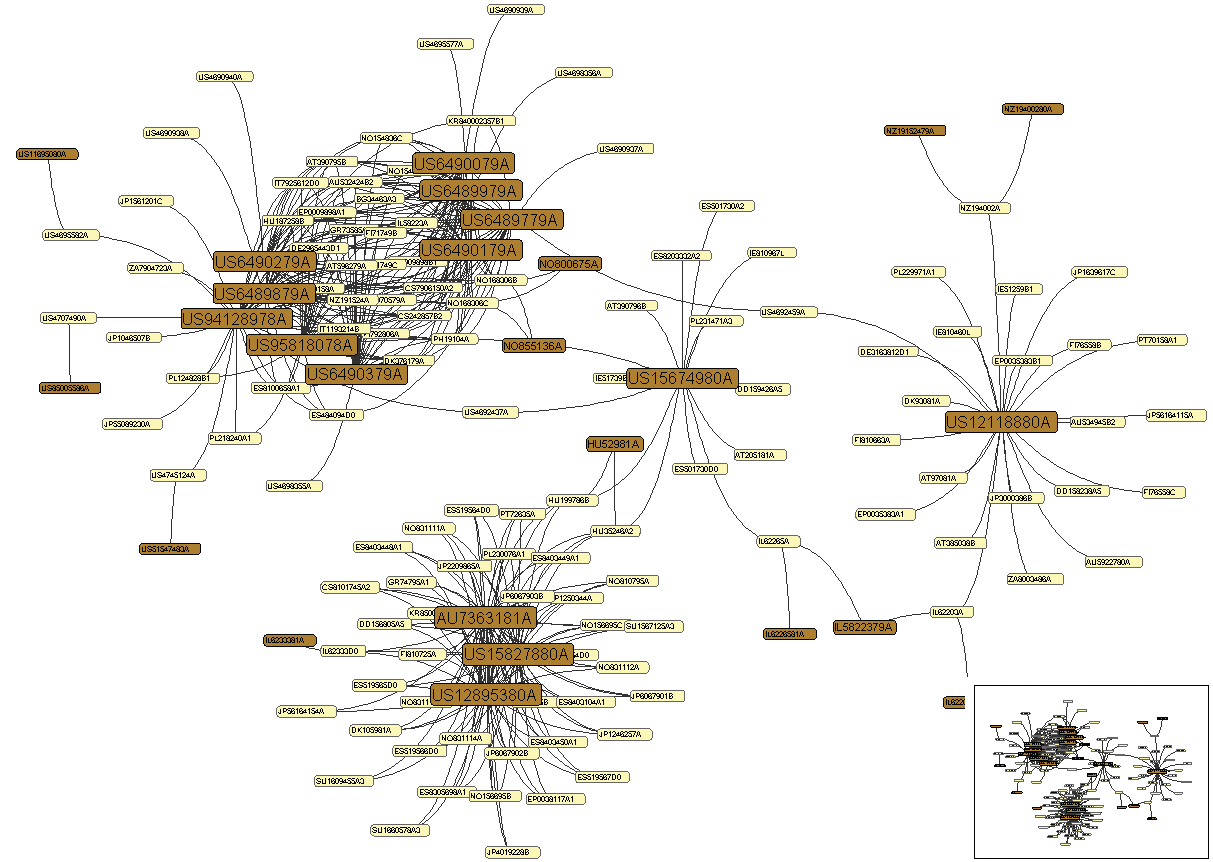Web Based Visual Exploration of Patent Information: Difference between revisions
No edit summary |
No edit summary |
||
| Line 31: | Line 31: | ||
During search, it is often a matter of concern to identify clusters or groups e.g. patents that are related to each other by different criteria (same category, same inventor, etc.) and visualize them in an appropriate manner. A common way to do this are (interactive) mass-spring graphs. They are an adequate and intuitive form of visualizing clusters and interrelations between paticular nodes. To simulate the physics of this kind of force-directed graphs, you can use the [http://en.wikipedia.org/wiki/Barnes-Hut_simulation Barnes-Hut Algorithm] that allows efficient n-body force calculations in O(n log n) time. | During search, it is often a matter of concern to identify clusters or groups e.g. patents that are related to each other by different criteria (same category, same inventor, etc.) and visualize them in an appropriate manner. A common way to do this are (interactive) mass-spring graphs. They are an adequate and intuitive form of visualizing clusters and interrelations between paticular nodes. To simulate the physics of this kind of force-directed graphs, you can use the [http://en.wikipedia.org/wiki/Barnes-Hut_simulation Barnes-Hut Algorithm] that allows efficient n-body force calculations in O(n log n) time. | ||
[[{{ns:6}}:Massspringgraph.gif |thumb| | [[{{ns:6}}:Massspringgraph.gif |thumb|left|250px|A Mass-Spring Graph]] | ||
[[Category:Techniques]] | [[Category:Techniques]] | ||
Revision as of 16:47, 27 May 2009
Motivation
On the one hand, patents are a well known instrument to protect intellectual properties. On the other hand, there are several aspects which are often neglected by the scientific community: analyzing patent information can lead to e.g. identification of the direction of technical change, forecasts of market values and getting insights into your competitors work and inventions. At present there are about 60 million patent documents existing worldwide mostly comprising natural language supplemented by figures, diagrams, formulas, etc. As a consequence of this, it is needless to allude that computer support is heavily required. Besides this, patent evaluation still takes a lot of human effort. Therefore, it is very important to explore new approaches in software supported retrieval and visualization of patent information. The main goal in this connection is to improve the users cognition processes; e.g. to faster identify potential search results/constraints etc.
Characteristics of Patent Information
Because of national patent laws, patent documents are following a well-defined structure arranged on a title page:
- bibliographic data and an abstract
- classificatory data
- description of the state of the art
- claims section
- images, diagrammes, formulae, etc. (optional)
As seen above, patent documents comprise some metadata such as bibliographic data and classificatory data. Nevertheless, for evaluation there often is some further information needed: The legal status and patent family information, which both have to be fetched from external data sources like the Europaean Patent Office
Legal Status
The legal status specifies significant events in the lifetime of a patent like changes of the owner etc.
Patent Family
Patents which describe the same invention belong to the same patent family. A common definition says that a patent document belongs to a respective patent family if the claims section and priorities of this document are matching the other patents claims and priorities of this family (e.g. protecting an invention in different countries).
Classificatory Data
The International Patent Classification (IPC) is the number one classification scheme of patent documents for ordering them in terms of technical fields. Therefore the IPC comprises 68.000 (advanced) or 17.000 (core) categories and is hierarchically organized in 13 levels.
Visualization Techniques
Mass-Spring Graphs
During search, it is often a matter of concern to identify clusters or groups e.g. patents that are related to each other by different criteria (same category, same inventor, etc.) and visualize them in an appropriate manner. A common way to do this are (interactive) mass-spring graphs. They are an adequate and intuitive form of visualizing clusters and interrelations between paticular nodes. To simulate the physics of this kind of force-directed graphs, you can use the Barnes-Hut Algorithm that allows efficient n-body force calculations in O(n log n) time.
